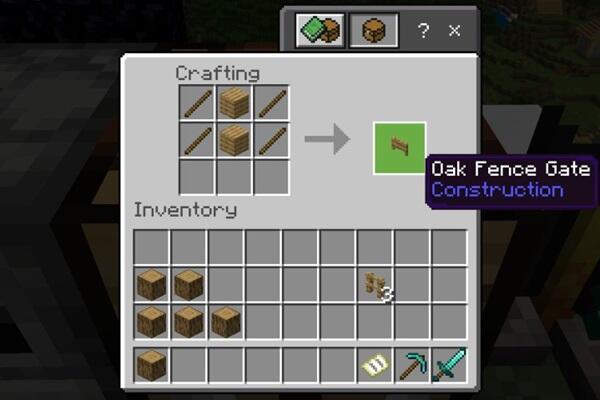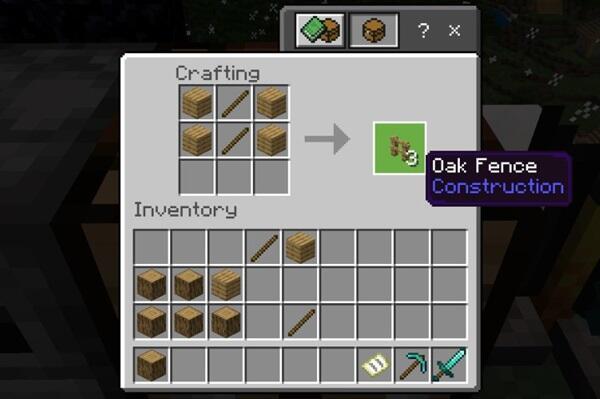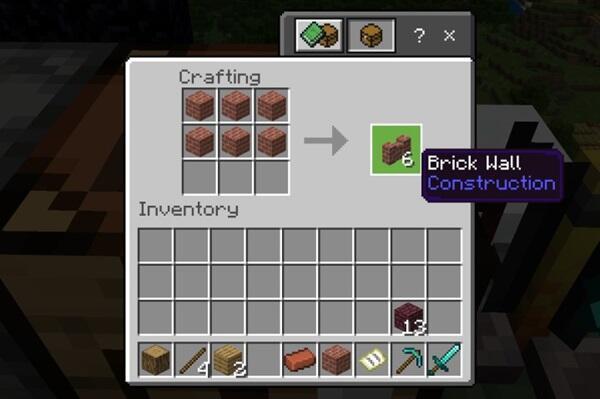Contents
Introduction to Fencing in Minecraft
Minecraft, a game that has captivated millions worldwide, is a canvas of creativity and survival where every block and item holds significance. Among these, fences stand out as more than just a functional item; they are a testament to the game’s depth and versatility. In the pixelated world of Minecraft, fences are not just boundaries or barriers; they represent the player’s ability to manipulate their environment, offering both protection and aesthetic appeal. Whether used to corral wandering livestock, to guard against nocturnal threats, or to add a charming touch to a homestead, fences in Minecraft serve a myriad of purposes. This versatility is what makes understanding how to craft and utilize them an essential skill for any aspiring Minecraft architect, especially in the touch-based interface of the Android version.

Understanding the Basics of Minecraft on Android
Playing Minecraft on Android devices offers a unique experience, distinct in several ways from its console or PC counterparts. Here are some key points highlighting these differences and similarities:
- Touchscreen Controls: Unlike the keyboard and mouse setup on PCs or controllers on consoles, Minecraft on Android relies on touchscreen controls. This offers a more tactile, intuitive experience, especially for crafting and inventory management.
- Portability: Android devices allow for Minecraft gameplay on the go. This mobility means players can enjoy the game anywhere, adding a layer of convenience not found in traditional PC or console versions.
- Performance and Graphics: While the core gameplay remains consistent across platforms, Minecraft on Android may have different performance capabilities and graphics quality due to the varied hardware specifications of Android devices.
- Cross-Platform Play: Minecraft supports cross-platform play, allowing Android users to join friends on other devices like Xbox, PC, or PlayStation.
- Game Updates and Features: Updates and features are usually released simultaneously across all platforms, including Android. However, some features might be adapted or scaled for mobile compatibility.
- Mod and Server Accessibility: While mods and custom servers are a significant part of Minecraft’s PC version, their availability and implementation can vary on Android, often requiring additional apps or adjustments.
Understanding these aspects is crucial for an optimized Minecraft experience on Android, setting the stage for effective fence crafting and usage in the game.

Materials Needed for Crafting Fences
Crafting fences in Minecraft requires specific materials, primarily different types of wood and a crafting tool. Here’s a breakdown of what you’ll need:
Wood Planks: The primary ingredient for fence construction. You can use any type of wood, including Oak, Spruce, Birch, Jungle, Acacia, and Dark Oak. Each wood type gives the fence a distinct color and texture.
- Oak Wood: Commonly found in most biomes, oak is versatile and easy to harvest.
- Spruce Wood: Located in Taiga and snowy biomes, spruce offers a darker color.
- Birch Wood: With its distinctive white bark, birch can be found in forest biomes.
- Jungle Wood: Sourced from jungle biomes, this wood has a unique, reddish hue.
- Acacia Wood: Found in savanna biomes, acacia stands out with its grayish plank color.
- Dark Oak Wood: Harvested from dark forests, it offers a rich, brown color.
Sticks: Essential for the fence’s framework. Sticks can be crafted from any type of wood plank by placing two planks vertically in the crafting area.
Crafting Table: A must-have for combining the planks and sticks into fences. You can create a crafting table by placing four wooden planks in a 2×2 grid in your crafting interface.

Understanding these materials and their sources is the first step towards crafting fences in Minecraft, allowing for a variety of aesthetic choices and functional uses in your game world.
Step-by-Step Guide to Making Fences
Crafting fences in Minecraft on an Android device involves a series of straightforward steps. Follow this detailed guide to create your fences:
Gather Wood: First, collect the necessary amount of wood from trees. Different types of trees yield different colored wood, so choose according to your aesthetic preference.
Create Wood Planks: Open your crafting interface. Place the collected wood logs in any of the crafting slots to convert them into wood planks. Each log gives four planks.
Craft Sticks: Continuing in the crafting interface, place two wood planks vertically, one above the other, to get sticks. Four sticks are produced from two planks.
Access the Crafting Table: If you don’t have a crafting table, create one by placing four wood planks in a 2×2 grid in the crafting interface. Then, tap on the crafting table to bring up the larger crafting grid.

Arrange Materials for Fence Crafting: In the crafting table interface, place wood planks and sticks in the following pattern:
- First Row: Wood Plank, Stick, Wood Plank
- Second Row: Wood Plank, Stick, Wood Plank
This pattern will create 3 fence pieces.
Collect the Fences: Drag the crafted fences from the crafting table output to your inventory.
Placement in the Game World: Select the fences from your inventory. Tap on the location in the game world where you want to place the fence. You can join multiple fences together by placing them side by side.
Experiment with Designs: Feel free to experiment with different wood types and designs to create unique fence styles that suit your Minecraft world.
By following these steps, you can efficiently craft and place fences in your Minecraft world on Android, adding both functionality and style to your builds.
Creative Uses of Fences in Game

Fences in Minecraft are not just barriers; they can be used creatively for various purposes. Here are some innovative and functional ways to use fences:
- Animal Pens: Create enclosures to keep and breed animals like cows, sheep, pigs, and chickens. Fences prevent these animals from wandering off and protect them from predators.
- Garden Borders: Use fences to outline gardens or farms. They can keep out unwanted creatures while adding a decorative touch to your agricultural areas.
- Property Boundaries: Define the limits of your territory or home base. Fences can be used to mark your property, adding a sense of ownership and organization to your Minecraft world.
- Elevated Walkways: Build elevated paths or bridges with fences as railings for safe passage over challenging terrains, like water bodies or ravines.
- Decoration: Incorporate fences into your architectural designs. They can be used for balcony railings, window bars, or as a part of intricate structures for aesthetic enhancement.
- Fortification: In survival mode, fences can serve as a defensive barrier against hostile mobs. They can be strategically placed around your base or in vulnerable areas for added protection.
- Parkour Elements: For those who enjoy the athletic aspect of Minecraft, fences can be used to create challenging parkour courses due to their narrow and tall structure.
- Village Enhancement: Use fences to improve the look and functionality of NPC villages. They can add to the village’s aesthetics while providing practical benefits like villager containment and defense.
These varied applications of fences in Minecraft showcase their versatility, allowing players to enhance both the functionality and the visual appeal of their in-game creations.
Troubleshooting Common Issues
When engaging in the art of fence crafting and placement in Minecraft, players might encounter certain challenges. Addressing these effectively can enhance your gaming experience.

One common issue is running out of materials while crafting fences. This can be particularly frustrating during large building projects. The solution is to ensure you have ample resources before starting. Plan your project size and gather more materials than you think you’ll need. Remember, each log gives four planks, and each plank can be turned into two sticks, so resource management is key.
Another frequent problem is incorrect fence placement, leading to gaps or misaligned structures. This often occurs in hasty building sessions. To avoid this, take your time while placing fences, especially in complex designs or uneven terrain. If a fence is placed incorrectly, simply break it with your hand or tool to collect it back into your inventory.
Players also sometimes struggle with connecting fences to other blocks or structures. Fences only connect to solid blocks and other fences. If you’re trying to attach a fence to a non-solid block, like glass, it won’t connect. Plan your design accordingly, using solid blocks where fence connections are needed.
Lastly, players on Android might face difficulty with precise placement due to touchscreen controls. To tackle this, zoom in on your screen or adjust your tapping technique for better accuracy. With practice, the touchscreen interface becomes an intuitive tool for precise building.
By understanding and addressing these common issues, you can streamline your fence crafting and placement process in Minecraft, leading to a more enjoyable and efficient building experience.
Conclusion: Enhancing Your Minecraft Experience
In the realm of Minecraft on Android, mastering the art of fence crafting and utilization is more than a mere survival skill; it’s a pathway to enriching your gaming experience. Fences bring structure, beauty, and functionality to your virtual world. They enable you to express creativity, secure your possessions, and elevate your architectural designs. Whether you’re building a humble homestead, an elaborate fortress, or a sprawling farm, fences play a pivotal role in bringing your Minecraft visions to life. Embracing this element of gameplay on Android adds depth and enjoyment, making every session a unique adventure. Remember, in Minecraft, every block, no matter how small, contributes to the larger story you create.